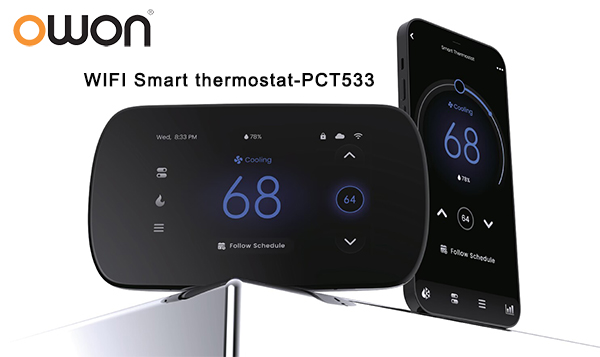Introduction: Redefining Comfort and Energy Efficiency in Modern Buildings
In commercial buildings and high-end residential projects, temperature consistency has become a critical measure of space quality. Traditional single-point thermostat systems fail to address zone temperature variations caused by solar exposure, space layout, and equipment heat loads. Multi-zone smart thermostat systems with remote sensors are emerging as the preferred solution for HVAC professionals across North America.
1. Technical Principles and Architectural Advantages of Multi-Zone Temperature Control
1.1 Core Operating Modes
- Central control unit + distributed sensor architecture
- Dynamic data collection and adaptive adjustment
- Intelligent scheduling based on actual usage patterns
1.2 Technical Implementation
Using OWON’s PCT533 as an example:
- Supports networking of up to 10 remote sensors
- 2.4GHz Wi-Fi and BLE connectivity
- Compatible with most 24V HVAC systems
- Sub-GHz RF for sensor communication
2. Critical Challenges in Commercial HVAC Applications
2.1 Temperature Management Issues
- Hot/cold spots in large open areas
- Varying occupancy patterns throughout the day
- Solar heat gain differences across building orientations
2.2 Operational Challenges
- Energy waste in unoccupied zones
- Complex HVAC system management
- Meeting evolving ESG reporting requirements
- Compliance with building energy codes
3. Advanced Multi-Zone Solutions for Professional Applications
3.1 System Architecture
- Centralized control with decentralized execution
- Real-time temperature mapping across zones
- Adaptive learning of occupancy patterns
3.2 Key Technical Features
- Zone-specific scheduling (7-day programmable)
- Occupancy-based automation
- Energy consumption analytics (daily/weekly/monthly)
- Remote system monitoring and diagnostics
3.3 OWON’s Engineering Approach
- Industrial-grade components rated for -10°C to 50°C
- TF card slot for firmware updates and data logging
- Dual-fuel and hybrid heat pump compatibility
- Advanced humidity sensing (±5% accuracy)
4. Professional Application Scenarios
4.1 Commercial Office Buildings
- Challenge: Varying occupancy across departments
- Solution: Zone-based scheduling with occupancy sensing
- Result: 18-25% reduction in HVAC energy costs
4.2 Multi-Family Residential
- Challenge: Individual tenant comfort preferences
- Solution: Customizable zone controls with remote management
- Result: Reduced service calls and improved tenant satisfaction
4.3 Educational & Healthcare Facilities
- Challenge: Strict temperature requirements for different areas
- Solution: Precision zone control with redundant monitoring
- Result: Consistent compliance with health and safety standards
5. Technical Specifications for Professional Deployment
5.1 System Requirements
- 24VAC power supply (50/60 Hz)
- Standard HVAC wiring compatibility
- 2-stage heating/cooling support
- Heat pump with auxiliary heat capability
5.2 Installation Considerations
- Wall mounting with included trim plate
- Wireless sensor placement optimization
- System commissioning and calibration
- Integration with existing building management systems
6. Customization Capabilities for OEM/ODM Partners
6.1 Hardware Customization
- Brand-specific enclosure designs
- Custom sensor configurations
- Specialized display requirements
6.2 Software Customization
- White-label mobile applications
- Custom reporting formats
- Integration with proprietary systems
- Specialized control algorithms
7. Implementation Best Practices
7.1 System Design Phase
- Conduct thorough zone analysis
- Identify optimal sensor locations
- Plan for future expansion needs
7.2 Installation Phase
- Verify compatibility with existing HVAC equipment
- Calibrate sensors for accurate readings
- Test system integration and communication
7.3 Operational Phase
- Train maintenance staff on system operation
- Establish monitoring protocols
- Implement regular system audits
8. Frequently Asked Questions (FAQ)
Q1: What’s the maximum distance between the main unit and remote sensors?
A: Under normal conditions, sensors can be placed up to 100 feet away through typical building materials, though actual range may vary based on environmental factors.
Q2: How does the system handle Wi-Fi connectivity issues?
A: The thermostat continues operating on its programmed schedule and stores data locally until connectivity is restored.
Q3: Can the system integrate with existing building automation systems?
A: Yes, through available APIs and integration protocols. Our technical team can provide specific integration support.
Q4: What support do you provide for OEM partners?
A: We offer comprehensive technical documentation, engineering support, and flexible customization options to meet specific project requirements.
9. Conclusion: The Future of Professional HVAC Control
Multi-zone smart thermostat systems represent the next evolution in building climate control. By providing precise zone-by-zone temperature management, these systems deliver both superior comfort and significant energy savings.
For HVAC professionals, system integrators, and building managers, understanding and implementing these systems is becoming essential for meeting modern building standards and occupant expectations.
OWON’s commitment to reliable, scalable, and customizable thermostat solutions ensures that our professional partners have the tools needed to succeed in this evolving market.
Post time: Nov-14-2025
